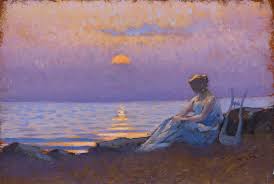This week, we’re looking at the fine art of painting.
Winslow Homer was born in Boston, Massachusetts in 1836. Raised in the-rural Cambridge, his artistic tendencies were encouraged by his mother, an amateur painter. At 19, he was apprenticed to a commercial lithographic firm in Boston. In 1859, Homer moved to New York, working as a free-lance illustrator.
In 1861, he was sent to the battlefront in the Civil War. By 1863 he was painting the war, doing mostly camp scenes. As the war drew to a close, his works began to explore the impact of the war.
After the war, he returned to New York City and began a period artistic experimentation. Financing his art by working as a magazine illustrator, his reputation began to build. Even though he lived in New York, his paintings were set anywhere but, with a large number focusing on the New Jersey and Massachusetts sea shores, the Adirondack and White Mountains and rural New England.
Women were always a favorite subject. In this painting, Eagle Head, Manchester, Massachusetts (High Tide)
(1870), we see a trio of young woman at the shore, apparently at the end of their walk. One wrings the water from her dress, while another seems to be dumping the sand from her shoes. The third is looking down, at what we can’t see. Their dog looks on, apparently alarmed at the source of the water falling to the sand. The beach, the water and the headland in the background are all simplified, concentrating your attention on his female subjects.
Homer’s fame rose, and in 1875 he was able to quit his day job and concentrate on his art. As he reached early middle age, he grew more solitary, the subjects of his paintings also grew more solitary and intimate. He moved to England in 1881, and for 2-ish years he sketched and painted the people of Cullercoats, a fishing village on the North Sea. Here he learned more about light and nature.
In 1883, he again moved, this time to Prouts Neck, Maine. Prouts Neck served as his base of operations for the remainder of his life as he traveled and then painted the scenes he had seen. In the later 1880s, his works turned to the sea and of heroic men of the sea. By 1890 he was concentrating on the sea itself. He traveled extensively from Canada to the Caribbean.
In the 1890s he abandons humanity as his primary subject, concentrating on nature. By the turn of the century, he was considered “crusty” and continued to withdraw from society. At this time he created some of his greatest works, including The Gulf Stream in 1899. Homer continued to paint until the end, dying in his studio in 1910.
(Sources: Metropolitan Museum of Art and the Encyclopedia Britannica.)




